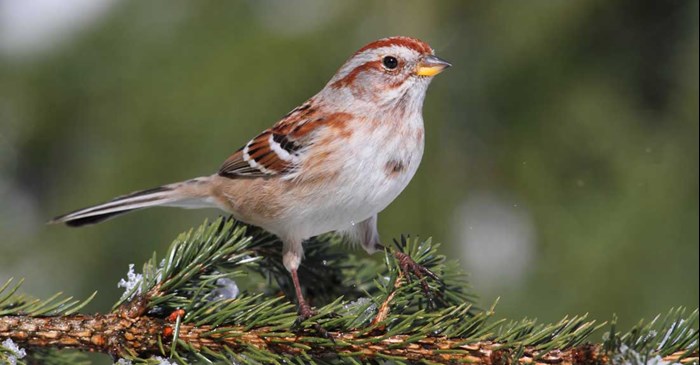The sweet song of the American Tree Sparrow is sure to gladden the heart of any winter-weary bird lover. Sometimes called the “winter sparrow”, this bird is common in all but the southernmost states of the U.S. from fall to winter. In late winter, males begin to sing their high-pitched whistles in hopes of attracting a mate to raise a brood of chicks within their summer home in the Alaskan and Canadian tundra.
Though their name may suggest otherwise, the American Tree Sparrow spends much of its time on the ground, not in trees. Early European settlers named them for their similar appearance to the gray and brown Eurasian Tree Sparrow back home.
The American Tree Sparrow is often confused with the Chipping Sparrow. Both have brown caps, a brown eyeline and brown striped wings. A practiced eye can spot subtle differences such as the sometimes visible brown spot on the Tree Sparrow’s breast. The easiest way to discern them is by their bills. The American Tree Sparrow has a bi-colored bill, with a dark upper mandible and yellow lower mandible, while Chipping Sparrows have pink bills.
In fall and winter, flocks of American Tree Sparrows spend much of their days in weedy fields, marshes and open forests, foraging for seeds from grass heads, sedge, ragweed, knotweed and goldenrod. Described as hardy, industrious and innovative, they use techniques like beating their wings to loosen seeds from grass heads. They also continue their search for food even in blizzard conditions. Stakes are high for these birds, because even one day of fasting puts their lives at risk. They need to consume up to 30 percent of their weight in both food and water each day. (Their weight ranges from .63 to .98 ounce.)
In the spring, as snow cover recedes in the northern U.S., the American Tree Sparrow sets off for the tundra to mate and nest. Females build their nests on the ground, usually in a grassy area, a bush base, or a low willow branch. During this time, their diet is focused mostly on insects, as their rapidly growing nestlings benefit from the high protein content.
The American Tree Sparrow regularly visits bird feeders, often foraging for fallen seeds on the ground. In winter, attract these birds to your yard with Lyric Supreme Mix, filled with American Tree Sparrow favorites such as black oil sunflower seeds, shelled peanuts, safflower seeds, black striped sunflower seeds, pecans, pistachios, Nyjer seed, sunflower kernels, and more!
